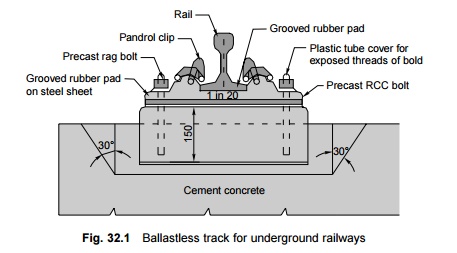Chapter: Civil : Railway Airport Harbour Engineering : Railway Engineering : Modernization of Railways and High Speed Trains
Ballastless Track
Ballastless Track
The technical concept of a
railway track consisting of ballast, sleepers, and rails is very old and has
stood the test of time. Such a system is simple and can be rapidly extended,
renewed, or dismantled. The general problem that occurs with ballasted tracks
is that the ballast material slowly deteriorates due to the load of the
traffic. The breaking of the ballast under the pressure exerted by the load
causes geometrical unevenness and clogging of the ballast bed by fine
particles. Therefore, regular maintenance is needed to restore track alignment.
The experience in Germany and other countries has been that the conventional
track may be used for speeds of up to 250 km/h but not beyond that. For higher
speeds, the construction of a ballastless track is required. In a ballastless
track, the rails are directly fastened to the concrete slab using elastic
fastenings. A ballastless track is expensive but is likely to require little or
no maintenance during its lifetime. The success of a ballastless track is
primarily based on the following advantages it offers.
Stability, precision, and comfort
A
ballastless track assures a permanently stable track and can withstand
the heavy load of high-speed train traffic. Its performance is characterized by
top quality, functionality and safety. The precise adjustment of the track up
to the last millimetre while it is being assembled at the construction site is
the prerequisite for ride comfort as well as reduction of pressure loads
experienced by the rolling stock.
Long life-span with practically
no maintenance With a service life of at least 60 years
and with little or no requirement for service or maintenance, a ballastless
track offers great viability and unmatched cost effectiveness in high-speed
operations.
Flexibility and end-to-end
effectiveness in application With its comparatively low
structural height and the possibility of the achievement of the optimal track
alignment, ballastless track technology offers highly attractive and beneficial
solutions as an end-to-end system technology for main-track and turnout
sections. This technology can be applied on a uniform basis on embankments,
bridges, and tunnels.
Basis for optimal routing of rail lines
The use of a ballastless track
for high-speed operations enables a more direct routing of train lines, with
tighter radii and greater slopes. These benefits enable the reduction, or even
elimination, of the costs of and the work required on civil engineering
structures. These benefits have led to the application of ballastless track
technology in the major projects for rail lines currently being undertaken in
Germany, where approximately 800 km of ballastless track has been installed
since 1991, as well as in other major projects around the world. The
ballastless track has found applications in many areas, as detailed in Table
32.3.
Table 32.3 Applications of
ballastless tracks

The Indian Railways does not have any plans for providing
ballastless tracks for high-speed routes because the maximum permissible speed
is only 140 km/h at present. However, ballastless tracks are provided in the
case of underground railways due to other considerations. Figure 32.1 shows the
cross section of a ballastless track for underground railways.

Related Topics